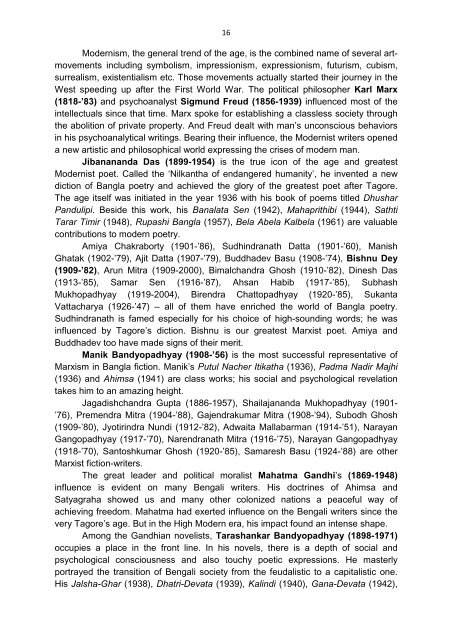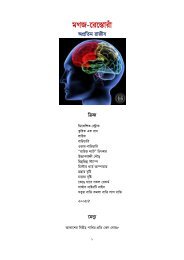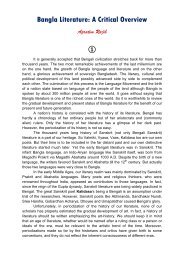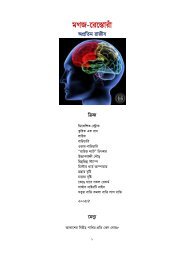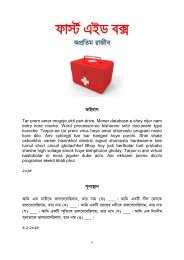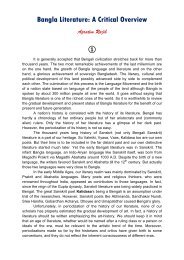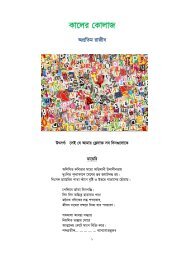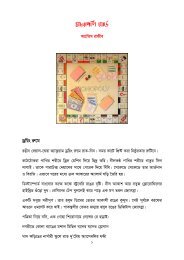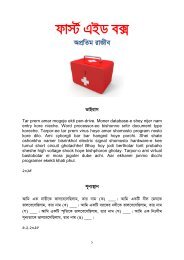BLiterature-Apratim
Create successful ePaper yourself
Turn your PDF publications into a flip-book with our unique Google optimized e-Paper software.
16<br />
Modernism, the general trend of the age, is the combined name of several artmovements<br />
including symbolism, impressionism, expressionism, futurism, cubism,<br />
surrealism, existentialism etc. Those movements actually started their journey in the<br />
West speeding up after the First World War. The political philosopher Karl Marx<br />
(1818-’83) and psychoanalyst Sigmund Freud (1856-1939) influenced most of the<br />
intellectuals since that time. Marx spoke for establishing a classless society through<br />
the abolition of private property. And Freud dealt with man’s unconscious behaviors<br />
in his psychoanalytical writings. Bearing their influence, the Modernist writers opened<br />
a new artistic and philosophical world expressing the crises of modern man.<br />
Jibanananda Das (1899-1954) is the true icon of the age and greatest<br />
Modernist poet. Called the ‘Nilkantha of endangered humanity’, he invented a new<br />
diction of Bangla poetry and achieved the glory of the greatest poet after Tagore.<br />
The age itself was initiated in the year 1936 with his book of poems titled Dhushar<br />
Pandulipi. Beside this work, his Banalata Sen (1942), Mahaprithibi (1944), Sathti<br />
Tarar Timir (1948), Rupashi Bangla (1957), Bela Abela Kalbela (1961) are valuable<br />
contributions to modern poetry.<br />
Amiya Chakraborty (1901-’86), Sudhindranath Datta (1901-’60), Manish<br />
Ghatak (1902-’79), Ajit Datta (1907-’79), Buddhadev Basu (1908-’74), Bishnu Dey<br />
(1909-’82), Arun Mitra (1909-2000), Bimalchandra Ghosh (1910-’82), Dinesh Das<br />
(1913-’85), Samar Sen (1916-’87), Ahsan Habib (1917-’85), Subhash<br />
Mukhopadhyay (1919-2004), Birendra Chattopadhyay (1920-’85), Sukanta<br />
Vattacharya (1926-’47) – all of them have enriched the world of Bangla poetry.<br />
Sudhindranath is famed especially for his choice of high-sounding words; he was<br />
influenced by Tagore’s diction. Bishnu is our greatest Marxist poet. Amiya and<br />
Buddhadev too have made signs of their merit.<br />
Manik Bandyopadhyay (1908-’56) is the most successful representative of<br />
Marxism in Bangla fiction. Manik’s Putul Nacher Itikatha (1936), Padma Nadir Majhi<br />
(1936) and Ahimsa (1941) are class works; his social and psychological revelation<br />
takes him to an amazing height.<br />
Jagadishchandra Gupta (1886-1957), Shailajananda Mukhopadhyay (1901-<br />
’76), Premendra Mitra (1904-’88), Gajendrakumar Mitra (1908-’94), Subodh Ghosh<br />
(1909-’80), Jyotirindra Nundi (1912-’82), Adwaita Mallabarman (1914-’51), Narayan<br />
Gangopadhyay (1917-’70), Narendranath Mitra (1916-’75), Narayan Gangopadhyay<br />
(1918-’70), Santoshkumar Ghosh (1920-’85), Samaresh Basu (1924-’88) are other<br />
Marxist fiction-writers.<br />
The great leader and political moralist Mahatma Gandhi’s (1869-1948)<br />
influence is evident on many Bengali writers. His doctrines of Ahimsa and<br />
Satyagraha showed us and many other colonized nations a peaceful way of<br />
achieving freedom. Mahatma had exerted influence on the Bengali writers since the<br />
very Tagore’s age. But in the High Modern era, his impact found an intense shape.<br />
Among the Gandhian novelists, Tarashankar Bandyopadhyay (1898-1971)<br />
occupies a place in the front line. In his novels, there is a depth of social and<br />
psychological consciousness and also touchy poetic expressions. He masterly<br />
portrayed the transition of Bengali society from the feudalistic to a capitalistic one.<br />
His Jalsha-Ghar (1938), Dhatri-Devata (1939), Kalindi (1940), Gana-Devata (1942),


